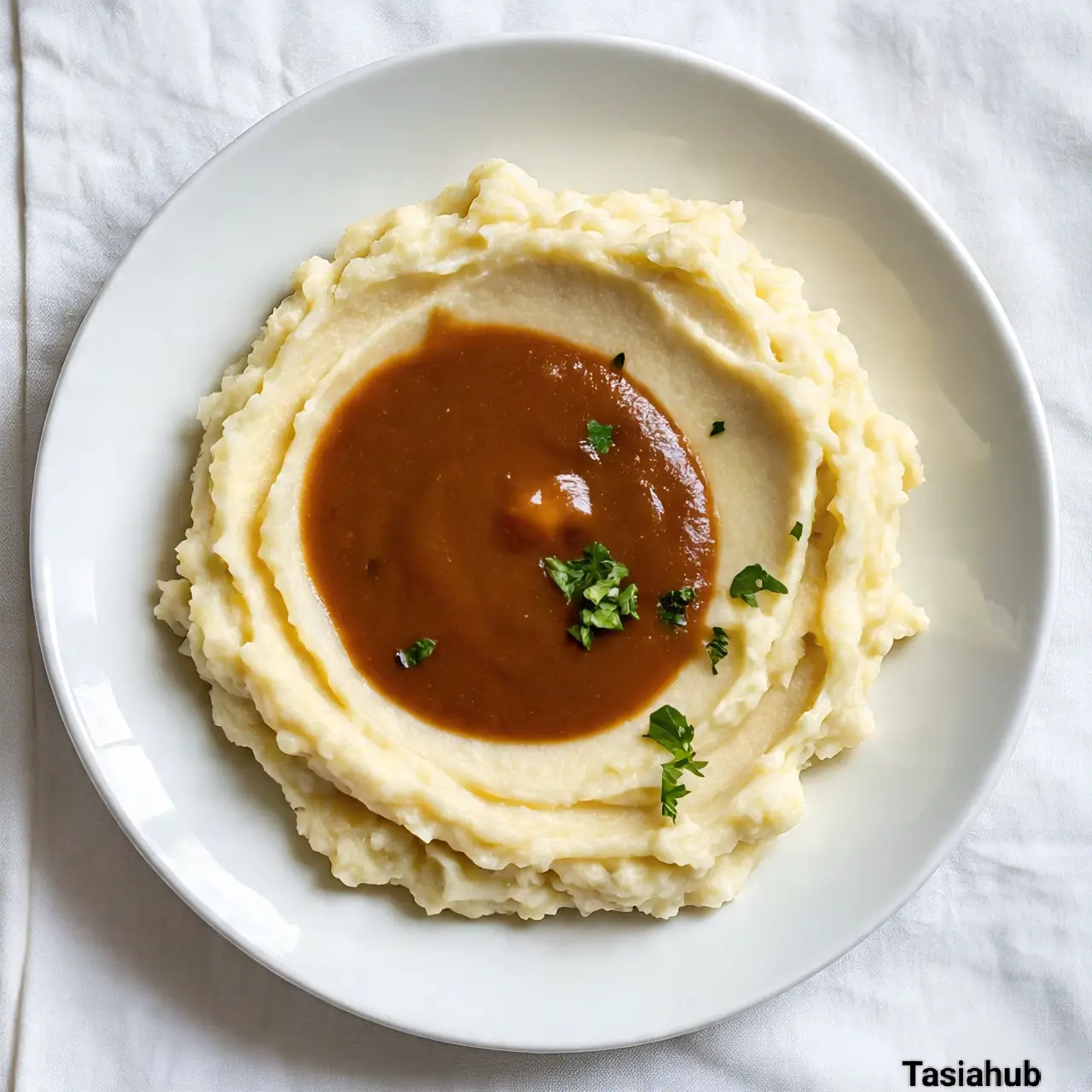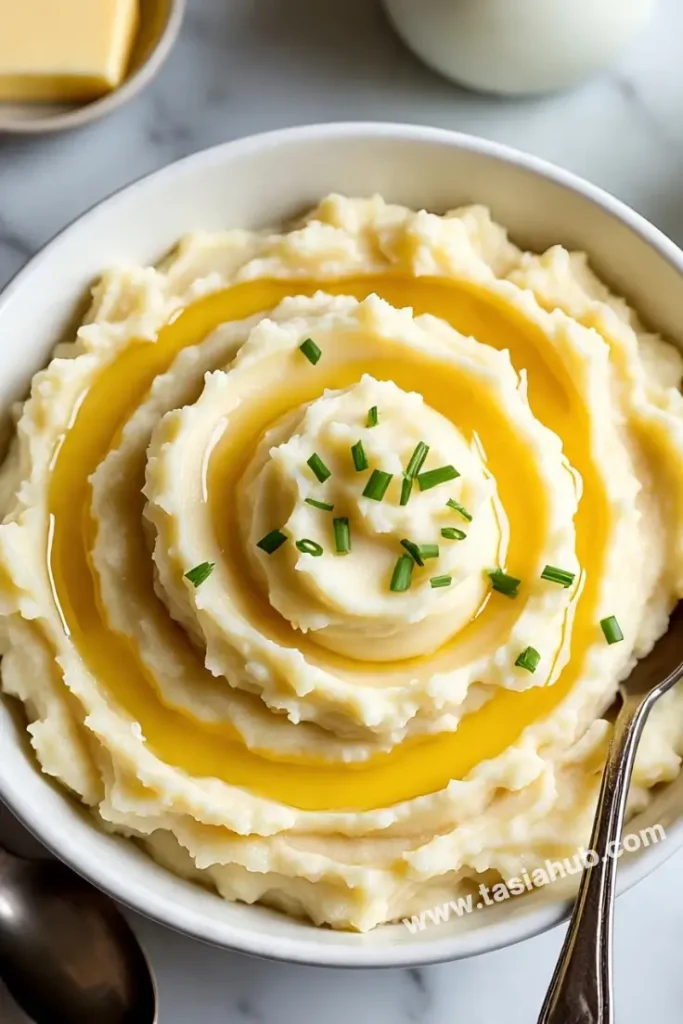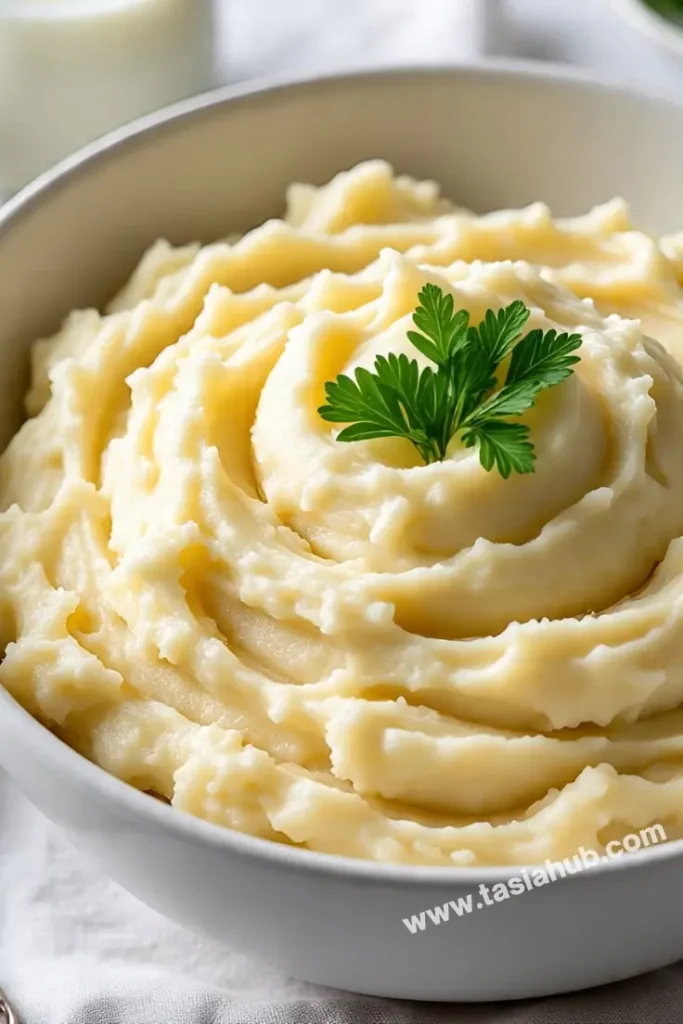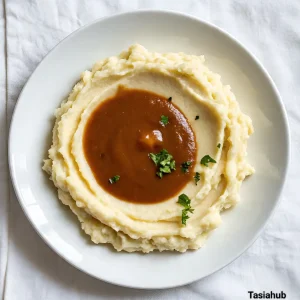Yummy Mashed Potatoes

Mashed potatoes are one of those comfort foods that seem to make everything better—rainy days, long weeks, holiday dinners, or even just a random Tuesday night. They’re warm, creamy, and deliciously versatile. Whether you’re piling them high on your Thanksgiving plate or scooping them beside a juicy steak, mashed potatoes have a way of stealing the show.
The best part? They’re incredibly easy to make at home with just a few simple ingredients. And once you’ve mastered the basics, you can start experimenting with all kinds of add-ins—think roasted garlic, sour cream, herbs, or even cheese. They’re one of those recipes that let you tailor the texture and flavor to match your mood or the meal. Want them extra creamy? Add more butter and a splash of cream. Prefer them a little rustic? Keep a few lumps in and skip the peeling.
Mashed potatoes also carry a bit of nostalgia for many people. Maybe it’s the memory of your mom whipping up a bowl during Sunday dinner, or the scent of potatoes boiling away in the kitchen while a roast finishes in the oven. They bring that cozy, homemade touch to the table, and honestly, they’re the kind of side dish that makes any meal feel a bit more special.
And yes, while boxed mashed potatoes do exist (and have their place during hectic weeks), nothing quite compares to the texture and richness of homemade. Once you learn how to get them fluffy, buttery, and just the right amount of seasoned, it’s hard to go back. Let’s break down how to make the perfect batch from scratch.
Why You’ll Love It
- Super Comforting: Mashed potatoes are the ultimate cozy side dish—creamy, warm, and soothing with every bite.
- Simple Ingredients: You only need a handful of pantry staples like potatoes, butter, milk, and salt to make a batch.
- Customizable Texture: Whether you like them fluffy, creamy, chunky, or somewhere in between, you can make them exactly how you want.
- Pairs with Everything: From meatloaf to grilled veggies to roast chicken, mashed potatoes complement almost any main dish.
- Great for Leftovers: Turn them into potato cakes, shepherd’s pie, or just reheat and top with gravy—leftover mashed potatoes are incredibly versatile.
Ingredient List
- 2 pounds russet or Yukon gold potatoes, peeled and chopped
- 4 tablespoons unsalted butter
- ½ cup whole milk (warm)
- ¼ cup heavy cream (optional, for extra creaminess)
- Salt, to taste
- Freshly ground black pepper, to taste
- Optional: chopped chives, garlic, or shredded cheese for mix-ins
Ingredient Notes
- Russet or Yukon gold potatoes – These are the best for mashing. Russets are fluffy and starchy, while Yukon golds give a buttery texture. You can even mix both!
- Unsalted butter – I always use real, high-quality butter (like Kerrygold) for that rich, creamy flavor.
- Warm milk – Don’t add cold milk; warming it helps keep the potatoes from seizing or turning gluey.
- Heavy cream – Totally optional, but it takes mashed potatoes to a whole new level of luxurious.
- Salt – Don’t be shy here. Potatoes need plenty of seasoning to shine. Taste and adjust as needed.
- Add-ins – Garlic, chives, or a handful of cheddar can totally change the flavor—have fun with it!
Kitchen Equipment Needed
- Large pot – For boiling the potatoes evenly. I like using a heavy-bottomed pot so the heat distributes well.
- Colander – To drain the cooked potatoes quickly and thoroughly.
- Potato masher – The classic tool for that fluffy, rustic texture. I use an OXO masher—it’s comfy to grip and easy to clean.
- Hand mixer or potato ricer (optional) – For extra-smooth mashed potatoes. A ricer gives that restaurant-style finish.
- Measuring cups & spoons – To get the butter, milk, and seasoning just right.
- Wooden spoon or spatula – Great for stirring everything together gently without overworking the potatoes.
Instructions
Step 1: Prep the Potatoes
- Peel the potatoes and rinse under cold water to remove any dirt or starch.
- Chop them into evenly sized chunks (about 1½ to 2 inches) so they cook at the same rate.
Pro Tip: Don’t cut them too small—they’ll absorb more water and get watery when mashed.
Step 2: Boil the Potatoes
- Place the chopped potatoes in a large pot and cover with cold water by about an inch.
- Add a generous pinch of salt to the water (just like pasta water—it helps season the potatoes from within).
- Bring to a boil over medium-high heat, then reduce to a simmer.
- Cook for 15–20 minutes, or until the potatoes are fork-tender and break apart easily when pierced.
Pro Tip: Start with cold water so the potatoes cook evenly from the inside out.
Step 3: Drain and Dry
- Drain the potatoes in a colander and let them sit for 2–3 minutes to steam off excess moisture.
- If you want them extra dry (great for fluffy mashed potatoes), return them to the pot over very low heat for a minute or two, stirring gently.
Pro Tip: Dry potatoes = better texture. Extra moisture makes them gummy.
Step 4: Mash
- While the potatoes are still hot, mash them using a potato masher, ricer, or hand mixer—whatever texture you’re going for.
- Mash until mostly smooth, but avoid over-mixing (especially with a mixer), which can make them gluey.
Pro Tip: A ricer gives a silky-smooth mash, perfect if you’re going for a fancier finish.
Step 5: Add Butter, Milk & Season
- Add the butter first and stir until fully melted into the potatoes.
- Slowly pour in the warm milk (and cream, if using), mixing as you go. Add just enough until you reach your desired consistency.
- Season with salt and freshly ground black pepper to taste.
- Stir gently until everything is creamy and well blended.
Pro Tip: Always taste and adjust—potatoes soak up salt fast, so a little extra can make a big difference.
Step 6: Serve & Enjoy
- Spoon the mashed potatoes into a serving bowl.
- Top with a pat of butter, chopped chives, or a sprinkle of cheese if you like.
- Serve warm alongside your favorite main dish!

Tips and Tricks for Success
- Start with cold water – This helps the potatoes cook evenly, so you don’t end up with mushy outsides and undercooked centers.
- Salt the cooking water generously – It’s your first layer of seasoning and makes a huge difference in flavor.
- Mash while hot – Potatoes mash more smoothly when hot. If they cool down too much, they can get gluey.
- Warm your dairy – Always use warm milk and cream to keep the mash light and fluffy instead of sticky.
- Don’t overmix – Especially with a mixer. Overworked potatoes release too much starch and turn gluey fast.
Ingredient Substitutions and Variations
- Potatoes – Swap in red potatoes for a chunkier, skin-on rustic mash.
- Milk – Use half-and-half, plant-based milk (like oat or almond), or even broth for a lighter version.
- Butter – Vegan butter or olive oil works great for a dairy-free option.
- Creamy twist – Stir in sour cream, cream cheese, or Greek yogurt for a tangy, rich flavor.
- Flavor boosters – Try roasted garlic, caramelized onions, fresh herbs, grated parmesan, or even a pinch of nutmeg for added depth.
Serving Suggestions
- With gravy and roast chicken – A classic combo that never fails. The mashed potatoes soak up all that delicious gravy.
- Next to meatloaf or steak – Perfect for hearty weeknight dinners. The creaminess pairs well with rich, savory mains.
- Topped with sautéed mushrooms – A great vegetarian twist—earthy, flavorful, and super satisfying.
- As a base for shepherd’s pie – Just layer with seasoned ground meat and veggies, then bake until golden on top.
- I love mine with crispy fried chicken and a side of coleslaw—it’s the ultimate comfort meal!

Storage and Reheating Instructions
- To store – Let the mashed potatoes cool completely, then transfer to an airtight container. Refrigerate for up to 4 days.
- To freeze – Spoon into freezer-safe bags or containers. Flatten for easy stacking. Freeze for up to 1 month.
- To reheat (stovetop) – Warm over low heat with a splash of milk or broth, stirring often to bring back creaminess.
- To reheat (microwave) – Heat in 30-second bursts, stirring in between, and add a bit of butter or milk to refresh the texture.
- Avoid overheating – Too much heat can make them gluey. Gentle reheating is key!
Frequently Asked Questions
What are the best potatoes for mashed potatoes?
Russet and Yukon gold potatoes are your best bet. Russets are light and fluffy, while Yukon golds are creamy and buttery—both mash beautifully!
Can I make mashed potatoes ahead of time?
Yes! You can make them a day in advance. Just store in the fridge and reheat gently with a splash of milk or cream before serving.
How do I fix mashed potatoes that are too runny?
Add more mashed potatoes (if you have some), or stir in a bit of instant potato flakes, cream cheese, or even parmesan to thicken things up.
What if I don’t have a masher?
No worries! A fork works in a pinch for a chunkier mash, or use a hand mixer on low for a smoother texture. Just don’t overmix!
Can I make them dairy-free?
Absolutely. Swap butter for olive oil or vegan butter, and use unsweetened plant-based milk like almond or oat for a creamy, dairy-free version.
How do I keep mashed potatoes warm before serving?
Place them in a heat-safe bowl over a pot of simmering water (double boiler-style), or keep them in a covered slow cooker on the “warm” setting.
Did you try this recipe? Let me know in the comments how it turned out!
Don’t forget to share your photos on Instagram and tag me @tasiahub_ or use the hashtag #tasiahub. I’d love to see your creations!

Yummy Mashed Potatoes
Equipment
- Large pot
- Colander
- Potato masher
- Hand mixer or potato ricer (optional)
- Measuring Cups & Spoons
- Wooden spoon or spatula
Ingredients
- 2 pounds russet or Yukon gold potatoes peeled and chopped
- 4 tablespoons unsalted butter
- ½ cup whole milk warm
- ¼ cup heavy cream optional, for extra creaminess
- Salt to taste
- Freshly ground black pepper to taste
- Optional: chopped chives garlic, or shredded cheese for mix-ins
Instructions
Step 1: Prep the Potatoes
- Peel the potatoes and rinse under cold water to remove any dirt or starch.
- Chop them into evenly sized chunks (about 1½ to 2 inches) so they cook at the same rate.
- Pro Tip: Don’t cut them too small—they’ll absorb more water and get watery when mashed.
Step 2: Boil the Potatoes
- Place the chopped potatoes in a large pot and cover with cold water by about an inch.
- Add a generous pinch of salt to the water (just like pasta water—it helps season the potatoes from within).
- Bring to a boil over medium-high heat, then reduce to a simmer.
- Cook for 15–20 minutes, or until the potatoes are fork-tender and break apart easily when pierced.
- Pro Tip: Start with cold water so the potatoes cook evenly from the inside out.
Step 3: Drain and Dry
- Drain the potatoes in a colander and let them sit for 2–3 minutes to steam off excess moisture.
- If you want them extra dry (great for fluffy mashed potatoes), return them to the pot over very low heat for a minute or two, stirring gently.
- Pro Tip: Dry potatoes = better texture. Extra moisture makes them gummy.
Step 4: Mash
- While the potatoes are still hot, mash them using a potato masher, ricer, or hand mixer—whatever texture you’re going for.
- Mash until mostly smooth, but avoid over-mixing (especially with a mixer), which can make them gluey.
- Pro Tip: A ricer gives a silky-smooth mash, perfect if you’re going for a fancier finish.
Step 5: Add Butter, Milk & Season
- Add the butter first and stir until fully melted into the potatoes.
- Slowly pour in the warm milk (and cream, if using), mixing as you go. Add just enough until you reach your desired consistency.
- Season with salt and freshly ground black pepper to taste.
- Stir gently until everything is creamy and well blended.
- Pro Tip: Always taste and adjust—potatoes soak up salt fast, so a little extra can make a big difference.
Step 6: Serve & Enjoy
- Spoon the mashed potatoes into a serving bowl.
- Top with a pat of butter, chopped chives, or a sprinkle of cheese if you like.
- Serve warm alongside your favorite main dish!
Notes
Nutritional Value (per ½ cup serving)
- Calories: 150–200
- Carbohydrates: 30–35 grams
- Fat: 5–8 grams
- Protein: 2–3 grams
- Potassium: 500 mg
- Vitamin C: 10% of daily recommended intake
- Fiber: 2–3 grams